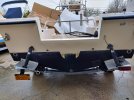DennisG01
GreatGrady Captain
- Joined
- Sep 1, 2013
- Messages
- 7,740
- Reaction score
- 1,517
- Points
- 113
- Location
- Allentown, PA & Friendship, ME
- Model
- Offshore
Ah, OK. Now I see what you're getting at. Bennett's SLT's are very similar to Smart Tabs, by Nauticus. Pretty much the same idea. I have zero experience with the SLT's, but I have LOT'S of experience with Smart Tabs on many different boats. The short of it... YES, you would be VERY happy with them (SLT or ST). Easy install and great bang for the buck.
I haven't looked into this - but if the tab, itself, would accept the hydraulic mounting, then yes, the same tab could be used. But, to be honest, if it didn't work... the removal of the SLT tab and installation of the "hydraulic" tab would be super easy. That would represent a fraction of the time it takes to install the entire hydraulic system. So... even if you couldn't re-use the SLT tab, it's no big deal.
The only caveat about installing the tab over the bottom paint is if the paint wasn't compatable with the metal tab. But, if it was me, I would probably end up sanding away the bottom paint in that area, anyways. But even that is only a few minutes of time. The important part is countersinking the screw holes to allow for a larger area for sealant and to avoid spider cracking.
I haven't looked into this - but if the tab, itself, would accept the hydraulic mounting, then yes, the same tab could be used. But, to be honest, if it didn't work... the removal of the SLT tab and installation of the "hydraulic" tab would be super easy. That would represent a fraction of the time it takes to install the entire hydraulic system. So... even if you couldn't re-use the SLT tab, it's no big deal.
The only caveat about installing the tab over the bottom paint is if the paint wasn't compatable with the metal tab. But, if it was me, I would probably end up sanding away the bottom paint in that area, anyways. But even that is only a few minutes of time. The important part is countersinking the screw holes to allow for a larger area for sealant and to avoid spider cracking.




